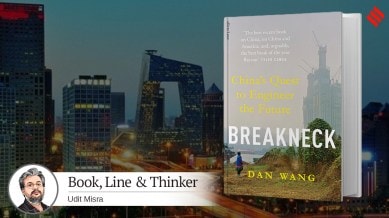Udit Misra is Senior Associate Editor. Follow him on Twitter @ieuditmisra ... Read More
© IE Online Media Services Pvt Ltd

Looking at Breakneck: China’s Quest to Engineer the Future — the cover, the title, the author’s name —one would be quite justified to think this book has been written by a Chinese and is about China and its desire to dominate the world. Well, one would be completely wrong.
The author Dan Wang is a Canadian technology analyst who left China with his parents when he was seven, and is currently a research fellow at the Hoover History Lab of Stanford University. But as an analyst he has closely tracked China while he worked in Hong Kong, Beijing and Shanghai.
The book is less about China’s quest but more about what the US can learn from China (and its quest) in order to maintain America’s lead even as China continues to aggressively bid for the top slot. It should not surprise then that the book is written not so much for the global audience but more like a direct letter to the Americans.
A letter that the Americans, both citizens and politicians, should take seriously. Of course, there are huge lessons here for India and Indians, just that they are not laid out as clearly.
So what’s the big idea of the book?
There is an all out conflict between the world’s top two economies and military powers. Wang says that the best hedge against heightening tensions between the two superpowers is “mutual curiosity”. The more informed Americans are about Chinese and vice versa, the more likely “we” are to stay out of trouble.
And here’s the most important bit that the Americans need to know:
“The starkest contrast between the two countries is the competition that will define the twenty-first century: an American elite, made up of mostly lawyers, excelling at obstruction, versus a Chinese technocratic class, made up of mostly engineers, that excels at construction.”
Simply put, China is an engineering state building at breakneck speed, in contrast to the US’ lawyerly society, blocking everything it can, good and bad.
As a lay reader will be able to immediately deduce: That’s not much of a fight. China will win because it can build at furious pace while the US is drowning under the weight of its inefficient and inadequate public infrastructure. The US can make a stunning argument but China is not wasting its time looking for a rebuttal: It wants to build and take over the world.
Since 1980, China has built an expanse of highways twice the size of the US systems, a high speed rail network twenty times more extensive than Japan’s and almost as much solar and wind capacity as the rest of the world put together. Wang points out that such is the Chinese dominance that today a rough rule of thumb is that China produces one-third to one-half of nearly any manufactured product on the planet.
As China has grown at this breakneck speed over the past 45 odd years, the US has steadily stopped producing things, and allowed public infrastructure to erode and with it the ability to build as well. Among many others, Wang provides a very striking example (and from an American perspective, an deeply embarrassing one) of the gap between the execution abilities of the two countries.
In 2008, California voters approved the building of a high-speed rail link between San Francisco and Los Angeles. This was also the time when China began the construction of a high-speed rail line between Beijing and Shanghai, roughly the same distance of around 800 miles (around 1300 km). China completed the line in 2011 at the cost of $36 billion. In its first decade of operation, it completed 1.35 billion passenger trips. California hasn’t built the full project yet. The latest cost estimate is $128 billion and it is expected that the first segment will start operating sometime between 2030 and 2033.
Wang points out that while China’s leadership is dominated by engineers, US leadership is dominated by lawyers. Deng Xiaoping promoted engineers through the 1980s and 90s. By 2002, all nine members of the Politburo’s standing committee were engineers.
In his third term, Xi (who is also a chemical engineer) further reinforced this trend. US leadership is, in contrast, led by lawyers and stuck in procedures and arguments. From 1984 to 2020, every single democratic presidential and vice-presidential nominee went to a law school. Lawyers also make the elites in the Republican Party. Only two American presidents (Herbert Hoover Jimmy Carter) and have been engineers by training.
The book details both the good bits of China’s obsession with engineering as well as the horror stories — one-child and zero-Covid etc. — of leaders trying to employ engineering principles on society. Clearly, those are not the excesses Wang wants the US to learn but he does repeatedly make the point that the US could reignite its enthusiasm for building and give up its obsession with procedures and its belief that government is the problem and fiscal constraints are binding.
In Wang’s worldview every time the US and China clash it is not just tragic but also “comical” since “no two peoples are more alike”. That, however, seems like a stretch. The fact is: the US doesn’t need to learn from China’s excesses. It can, instead, simply look back on its own glorious past of engineering and building world class infrastructure without subjugating its peoples freedoms. Dare I say, that is the path that its leaders are choosing in their own way — be it Donald Trump or Zohran Mamdani.